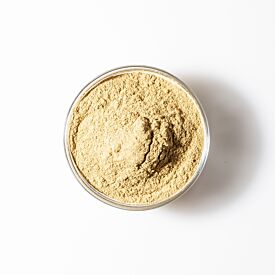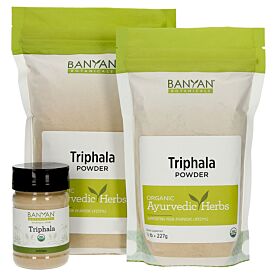An Ayurvedic Guide to Healthy Elimination

Ok. Let’s be completely honest for a moment. Who among us has not suffered from difficult bowel movements, occasional loose stools, or some other type of discomfort affecting the bowels? For many of us, these disturbances are familiar occurrences. And yet, as a culture, we’re morbidly afraid to talk about them.
Fortunately, Ayurveda has a lot to say about why these types of imbalances are so common and what we can do to correct them. So, perhaps it’s time to cast aside any resistance, stigma, or embarrassment in order to offer our bodies some real support in the area of elimination. This resource explores Ayurveda’s perspective on this topic in some depth.
In this article:
- What Defines Healthy Elimination
- Understanding the Channel of Elimination with Ayurveda
- Common Imbalances in the Channel of Elimination
- General Strategies to Support Healthy Elimination
- Your Unique Path to Healing
If you were hoping to find a few quick recommendations for an acute case of constricted bowel movements or loose stools, click on the appropriate link for some suggestions. But if your symptoms recur frequently, consider returning here soon so that you can begin to explore and address the root cause of your imbalances.
Ayurveda views elimination as an important indicator of overall health because healthy elimination generally points to strong digestion, or agni, which is one of the cornerstones of well-being and longevity.
Perhaps even more significantly, Ayurveda recognizes that the digestive tract is the very first place that imbalances arise in the body. This being the case, our stools tend to offer very early warning signs that something is amiss physiologically, even if the imbalance is fairly minor at first.
If an emerging imbalance is not properly addressed, it will either take root in the digestive tract (as a more serious condition), or spread to other tissues and create disturbances there. If, on the other hand, we can learn to understand and respond to the early indications of discord, our bodies have a remarkable ability to self-correct and heal.
It is amazing what we can learn about ourselves just by paying attention to our bowel habits and our stools. But, given the taboo nature of this topic, the easily observable indications of health and imbalance that can be seen in our daily cycles of elimination are often overlooked.
We hope that this exploration will be both enlightening and inspiring for you and that it will offer you a number of practical tools to support healthy elimination in your own life.
What Defines Healthy Elimination?
According to Ayurveda, healthy elimination occurs one to two times daily. In a perfect world, the first bowel movement of the day occurs within a few minutes of waking, ideally before sunrise. If there is a second bowel movement later in the day, it often occurs after a meal, in the afternoon or evening.
Balanced stools themselves:
- Are well-formed, about the consistency of a ripe banana.
- Maintain their shape after being eliminated.
- Are a light brownish-yellow color.
- Float (if eliminated into a toilet bowl containing water).
- Are slightly oily.
- Are not sticky; the anal orifice is easily cleaned and the stool does not stick to the toilet.
- Have only a mild odor.1
Does your reality fall a little short of the ideal? Most do. It’s not surprising, really. Leading fast-paced, stressful lives, ingesting processed foods, multitasking, and eating on the run can all take a significant toll on digestive health and excretory function.
But that’s why exploring this topic is so valuable—so that we can foster balance in our bowel habits and throughout our bodies.
Understanding the Channel of Elimination with Ayurveda
In Ayurveda, the physiological systems in the body (like the reproductive system or the urinary system) are called channels—each with important overall functions.
Many of us are accustomed to thinking about the digestive tract as a continuous whole, with each of its component parts—the mouth, the esophagus, the stomach, the small intestine, the colon—contributing to the complex process of refining ingested food until what’s left is finally eliminated as waste.
But consider this: over 5,000 years ago, Ayurveda distinguished the channel of food (which starts at the mouth and ends with the small intestine), from the channel of solid waste (which begins at the colon and continues to the anus).
It’s not that the ancient rishis were confused about the continuity of the human digestive tract. They simply recognized important distinctions in the functions (and the therapeutic treatment) of these two channels. While the two are certainly related and can impact one another, the first is more about taking food and nutrition into the body, and the second is primarily about eliminating waste.
Ayurveda emphasizes the importance of proper movement and flow throughout all channels of the body, and the channel of elimination is no different. Regular movement of the bowels is an essential part of keeping the digestive channels flowing properly.
But healthy elimination also carries out the critical functions of absorbing water and glucose, forming stools, eliminating solid waste, and clearing natural toxins from the body.1
Common Imbalances in the Channel of Elimination
While there are certainly many things we can do to generally foster healthy elimination (see general strategies below), identifying whether vata, pitta, kapha, or a combination of the doshas are involved in a specific imbalance allows us to pursue deeper and more focused therapeutic strategies. If you don't know which dosha to balance, take the dosha quiz.
The following table is meant to facilitate this process.
| Healthy Versus Imbalanced Stools1 | ||||
| Balanced | Vata | Pitta | Kapha | |
| Quantity | Moderate | Scanty | Moderate | Copious |
| Qualities | Slightly oily, soft | Dry, hard | Oily, liquid, hot | Oily, slimy, sticky, slow |
| Consistency | Similar to a ripe banana in shape and consistency | Bullet-like, similar to deer or rabbit droppings | Loose, semi-solid, frequently fall apart in the water | Well-formed (but often sticky, or with mucus) |
| Buoyancy | Floats (because there is no ama) | Sinks | Can float or sink | Sinks (may float with mucus) |
| Color | Light brownish-yellow | Dark brown | Yellow-green or red | Pale yellow |
| Odor | Mild, non-offensive | Slightly astringent, mild | Sour, pungent, acidic, very strong | Mild, may smell sweet |
| Regularity | 1–2 times per day, once upon waking | Irregular, once a day or less | Frequent (commonly at least 2–3 times per day) | 1–2 times per day, may not feel complete, and may occasionally skip a day |
| Subjective Experience | Easy and natural to pass | Difficult to pass, can cause straining and discomfort | Passes quickly; can feel hot, liquid, urgent | Often feels sluggish, slow, or incomplete; sticky; difficult to clean |
Sometimes it is very easy to identify personal tendencies at a glance—in which case, you’ll find more specific support for returning to balance here:
If you remain uncertain after reviewing the table, you’re welcome to peruse all three dosha-specific elimination guides to gain a deeper understanding of each type of imbalance. Or, a qualified Ayurvedic practitioner can offer a more personalized assessment of your needs.
More Complex Imbalances
It is also important to keep in mind that longstanding imbalances in the channel of elimination often involve more than one dosha, and can easily lead to more complex issues. Some conditions are more serious and should be treated only by qualified health practitioners.

General Strategies to Support Healthy Elimination
Whatever your specific imbalances, the following strategies tend to support healthy elimination on a very general level, and are typically appropriate for anyone.
Hydrate
Taking in an appropriate quantity and quality of fluids is a great place to start because being properly hydrated is critical to both digestion and elimination. How much fluid is appropriate can vary widely—depending on one’s age, constitution, imbalances, climate, and activity level.
But chances are that if you tend to have dark, pungent, or scanty urine, infrequent urination, a tendency toward strained bowel movements, or dry skin, you may be under-hydrated.
If you think you need more fluids, try drinking a cup or two of warm water upon waking, and a large glass (about two cups) of warm or room temperature water 20–30 minutes before your meals.
These tactics not only help cleanse and hydrate the tissues, but they can also awaken the digestive capacity and dramatically support digestion.3
- Ayurveda generally recommends avoiding iced beverages (including iced water) and does not recommend more than a few sips of water (or other beverages) with meals; these fluids, when taken with food, can dilute or inhibit the digestive process.
- In general, it is best to avoid drinks that are loaded with sugar or caffeine, like soda or coffee.
- And finally, focus on receiving adequate amounts of cleansing, hydrating fluids—we’re talking primarily water and herbal teas (though small amounts of fruit and vegetable juice can also be supportive for some).
Implement a Daily Routine
Physiologically, our bodies are highly adapted to having a sense of routine. Ayurveda tends to be elegantly intuitive and this recommendation is a perfect illustration; it just makes sense that regularity in our schedules would foster regularity in our bowels.
If you don’t have much of a daily routine, consider starting with some simple focal points throughout your day: work toward getting up and going to sleep at about the same time, and try carving out a consistent time to eat breakfast, lunch, and dinner each day. These simple steps give our nervous systems a sense of normalcy, quiet the stress response, and support our bodies in carrying out routine physiological functions.
If your elimination is not especially regular, you might also consider setting aside a few minutes for a bowel movement each morning, even if there is no urge. Simply sit quietly on the toilet, breathe into your belly, and relax. Allowing your body the time and space to eliminate in this way each morning (even if nothing happens) can invite a more regular habit of doing so over time.
Exercise is also an important component of a routine—one that can be critically important to regular bowel habits. When we are underactive, the metabolic system slows and the bowels can become especially sluggish. Exercising 3–4 days per week fires up the metabolism and supports regular elimination. Even something as simple as a 20-minute brisk walk can make a big difference.
Ayurveda recommends different types and intensities of exercise for different individuals. For more specific recommendations, please see our Ayurvedic Guide to Exercise.
Eat Well
As you might expect, the Ayurvedic diet has a profound effect on elimination. A healthy diet emphasizes nutritious, seasonal, whole foods and limits processed foods and refined sugars. But in Ayurveda, it matters not only what we eat, but also when we eat, how much we eat—even how we eat.
For instance, it’s incredibly important to offer our full attention to the act of being nourished. Fostering a degree of presence with our food can dramatically improve our digestive capacity.
In addition, consider adopting the following Ayurvedic practices to further strengthen digestion and elimination.
Follow Your Hunger
Ayurveda views appetite as an important precursor to nourishment. Hunger is a natural indication that the body is ready to eat and that the digestive fire is strong enough to digest a meal, so it is best to eat only when we are hungry.2 But for many of us, distinguishing real hunger from a more emotional desire to eat can be tricky. We have to ask ourselves if we are emotionally objective.
And, if we have eaten a substantial meal within the last 3–4 hours, it’s quite possible that the “hunger” is more of an emotional craving. Real hunger comes with a natural feeling of lightness and clarity, a pleasant anticipation of eating, and is satisfied by food.4
Eat Appropriate Quantities of Food
In the West, we are generally accustomed to eating very large meals. Ayurveda recommends much smaller meals: just the amount of food that we could hold in our two cupped hands.
Another helpful guideline is to think about filling the stomach ⅓ with food, and ⅓ with water, leaving the final ⅓ empty for optimal digestion. Any water taken with a meal should be room temperature or warm, not iced.2 And ideally, we would not ever eat to full satiation.
Allow Adequate Time Between Meals
The metabolic function works best when it is allowed to completely digest one meal before it starts in on another. It is usually a good idea to allow at least 3–4 hours between meals. While this timeframe can vary based on the meal itself and the individual, the return of natural hunger is usually a good indicator that the digestive system is ready for action.
Undertake a Dietary Cleanse or Detox Program
Stoking the digestive fire with a cleanse can be an incredibly powerful way to support proper elimination and improved overall health.
The basic premise of an Ayurvedic cleanse is that our bodies are inherently intelligent; when we provide a break from the barrage of potentially harmful inputs, our bodies immediately allocate the extra energy to cleaning house—repairing and rejuvenating the system for optimal performance.
Cleanses can help clear toxins, balance the doshas, kindle a stronger digestive fire, and balance the cycles of elimination. A cleanse can be as simple as a half or full-day fast, a short juice cleanse, or a longer monodiet of something like kitchari.
Meditate to Reduce Stress
Stress can have a very detrimental impact on our overall health and is particularly disruptive to digestion and elimination. Ayurveda recognizes the power of a number of subtle therapies for stress management.
Meditation is a very effective technique; it helps minimize our experience of stress and also encourages the development of more constructive responses to stressful situations. Even 10–15 minutes of daily meditation can have a profound impact on your state of mind and your digestive health.
If you do not already have a meditation practice, Empty Bowl Meditation, as taught by Vasant Lad, MASc, is a simple but powerful practice appropriate for most anyone.
Devote a Few Minutes Each Day to Pranayama
Pranayama is the practice of working with the breath to affect both gross and subtle aspects of the body-mind. Like meditation, pranayama supports balance in the nervous system and begins to unwind the cycle of stress that can trigger imbalances in the digestive tract.
Pranayama also helps access and reset longstanding patterns in the energetic body. Further, by breathing deeply into the abdomen, we naturally unwind tension patterns that can inhibit digestion and elimination. Specific pranayamas for each dosha are recommended in our resources on vata-, pitta-, and kapha-type elimination.
Practice Yoga
Yoga is another therapy that can help help manage stress, strengthen digestion, and keep the channel of elimination relaxed and flowing properly. Specific practices for each dosha are recommended in our resources on vata-balancing, pitta-balancing, and kapha-balancing yoga.
Take Triphala
This traditional Ayurvedic formula is comprised of three fruits and is balancing for vata, pitta, and kapha. It is revered for its unique ability to gently cleanse and detoxify the digestive tract while it replenishes, nourishes, and rejuvenates the tissues.
Triphala supports digestion and a healthy gut microbiome. It has a particular affinity for the colon, and while it isn't meant to treat chronic constipation, it does help relieve occasional constipation and support regularity.
About half an hour before bed, take 1–4 Triphala tablets with a glass of warm water. If you prefer a powder, steep ¼–½ teaspoon Triphala powder in a cup of freshly boiled water for 10 minutes. Cool and drink. Or, you might try Triphala liquid extract instead.
Consider the Condition of Agni
When it comes to imbalances in the channel of elimination, identifying the root cause usually requires looking at and tending to the broader condition of digestion, or agni. If you are interested in understanding more about agni, please consider exploring these complementary resources:
- The Importance of Healthy Digestion
As an introduction to the critically important Ayurvedic concept of agni, this resource explores the role of digestion in maintaining health and vitality throughout the body, and offers practical tools for kindling the sacred fire within. - The Importance of Agni
This article explores the specific functions of agni, as well as the signs and symptoms of both healthy and impaired agni. - The Four Varieties of Agni
This resource compares balanced agni to the different types of imbalances that can disrupt it, and offers appropriate therapies for each type of imbalance. - Ama: the Antithesis of Agni
This article introduces the toxic, undigested material called ama, which has qualities that directly oppose those of agni. Ama in the body can either be the cause or the result of impaired agni—and in either case, threatens our health.
Your Unique Path to Healing
Ayurveda honors the body’s innate intelligence. In many cases, when we return the body to balance, it heals itself naturally, and our symptoms simply cease to exist. It’s also important to understand that, in Ayurveda, context is everything. Ayurveda teaches us to look beyond our symptoms and to identify the primary imbalance(s) behind them. Correcting the underlying cause is a fundamental part of the Ayurvedic journey.
This is why each individual’s situation is so important. Two people with the same complaint might be directed to follow individually nuanced treatment strategies. It all depends on who they are as individuals—their age, their constitution, their imbalances, their diet, their lifestyle, their strengths, and their weaknesses.
In other words, in Ayurveda, it matters how you arrived at this particular moment in time, and that context can help reveal where it is that you have the greatest capacity to heal—your unique entry point for profound change.
A qualified Ayurvedic practitioner can support you in getting to the bottom of and resolving your particular concerns. But with or without professional guidance, Ayurveda offers a number of elegant lifestyle practices to support optimal well-being.










